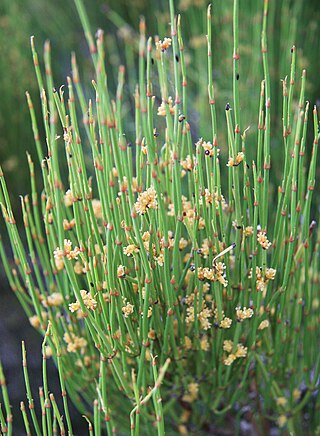
Ranunculaceae is a family of over 2,000 known species of flowering plants in 43 genera, distributed worldwide.

Actaea racemosa, the black cohosh, black bugbane, black snakeroot, rattle-top, or fairy candle, is a species of flowering plant of the family Ranunculaceae. It is native to eastern North America from the extreme south of Ontario to central Georgia, and west to Missouri and Arkansas. It grows in a variety of woodland habitats, and is often found in small woodland openings. The roots and rhizomes were used in traditional medicine by Native Americans. Its extracts are manufactured as herbal medicines or dietary supplements. Most dietary supplements containing black cohosh are not well-studied or recommended for safe and effective use in treating menopause symptoms or any disease. In contrast, some herbal medicinal products containing black cohosh extract hold a marketing authorization in several states of the European Union are well-studied and recommended for safe and effective use for the relief of menopausal symptoms such as hot flushes and profuse sweating attacks. Such differentiation between the product types seems to be important.

Hepatica is a genus of herbaceous perennials in the buttercup family, native to central and northern Europe, Asia and eastern North America. Some botanists include Hepatica within a wider interpretation of Anemone.

Actaea, commonly called baneberry, bugbane and cohosh, is a genus of flowering plants of the family Ranunculaceae, native to subtropical, temperate and subarctic regions of Europe, Asia and North America.

Apocynum, commonly known as dogbane or Indian hemp, is a small genus of the flowering plant family Apocynaceae. Its name comes from Ancient Greek ἀπόκυνονapókunon, from ἀπο-apo- "away" and κύωνkúōn "dog", referring to dogbane, which was used to poison dogs. The genus is native to North America, temperate Asia, and southeastern Europe.

Actaea spicata, the baneberry or herb Christopher, is a species of flowering plant in the genus Actaea, native from Europe to western Siberia and northern Iran. It is often found on limestone edges and in deciduous woodland; key factors are shade, low competition, and a cool, protected root run.

Ephedra is a genus of gymnosperm shrubs. The various species of Ephedra are widespread in many arid regions of the world, ranging across southwestern North America, southern Europe, northern Africa, southwest and central Asia, northern China and western South America. It is the only extant genus in its family, Ephedraceae, and order, Ephedrales, and one of the three living members of the division Gnetophyta alongside Gnetum and Welwitschia.

Actaea pachypoda, the white baneberry or doll's-eyes, is a species of flowering plant in the genus Actaea, of the family Ranunculaceae.

Andropogon is a widespread genus of plants in the grass family, native to much of Asia, Africa, and the Americas, as well as southern Europe and various oceanic islands.
Psilopeganum is a genus of flowering plants of the family Rutaceae.

Anemone hepatica, the common hepatica, liverwort, kidneywort, or pennywort, is a species of flowering plant in the buttercup family Ranunculaceae, native to woodland in temperate regions of the Northern Hemisphere. This herbaceous perennial grows from a rhizome.

Corylus americana, the American hazelnut or American hazel, is a species of deciduous shrub in the genus Corylus, native to the eastern and central United States and extreme southern parts of eastern and central Canada.
Actaea arizonica is a species of flowering plant in the buttercup family known by the common name Arizona bugbane. It is endemic to Arizona in the United States, where it occurs in Coconino, Gila, and Yavapai Counties. Like some other species in genus Actaea, this plant was formerly included in the genus Cimicifuga.
Ostryopsis nobilis is a shrub species in the genus Ostryopsis found in China. It is an endemic Chinese medicinal plant. It forms thickets on sunny mountain slopes between 1500 and 3000 m. It is found in South West Sichuan and North West Yunnan.
Matsumurella is a genus of flowering plants in the family Lamiaceae, first described in 1915. It is native to China and Japan. The genus is closely related to Galeobdolon, and the species below are discussed under that name in Flora of China.
- Matsumurella chinensis(Benth.) Bendiksby - Anhui, Fujian, Guangdong, Guangxi, Hunan, Jiangsu, Jiangxi, Taiwan, Zhejiang
- Matsumurella kwangtungensis(C.Y.Wu) Bendiksby - Guangdong
- Matsumurella szechuanensis(C.Y.Wu) Bendiksby - Chongqing
- Matsumurella tuberifera(Makino) Makino - Japan, Ryukyu Islands, Taiwan, Guangxi, Hunan, Jiangxi
- Matsumurella yangsoensis(Y.Z.Sun) Bendiksby - Guangxi

Heloniopsis, also called swamppink, is a genus of plants in the Melanthiaceae, first described as a genus in 1859. It is native to east Asia.

Sichuan pepper, also known as Szechuan pepper, Szechwan pepper, Chinese prickly ash, Chinese pepper, Timut pepper and malapepper, is a spice commonly used in Sichuan cuisine. Despite its name, Sichuan pepper is not closely related to black pepper or chili peppers. It is made from plants of the genus Zanthoxylum in the family Rutaceae, which includes citrus and rue.

Actaea simplex, the baneberry or bugbane, is a flowering plant in the buttercup family Ranunculaceae. A clump-forming rhizomatous herbaceous perennial, its native range includes the Kamchatka, Sakhalin and Siberian regions of Russia, western China, Manchuria, Mongolia, Korea and Japan. Plants may be harmful if eaten, and the sap may irritate the skin. The genus name Actaea is the Latin name adopted by Linnaeus from Pliny. The specific epithet simplex means simple or unbranched. The common name "bugbane" refers to the fact that the leaves' scent repels insects.
Ma is the Chinese word for cannabis. The term ma, used to describe medical marijuana by 2700 BCE, is the oldest recorded name for the hemp plant.

Actaea matsumurae, the Kamchatka bugbane or Japanese bugbane, is a species of flowering plant in the buttercup family Ranunculaceae, that is native to Japan, Mongolia and Eastern Russia. Other common names include baneberry, which is also applied to other Actaea species.















